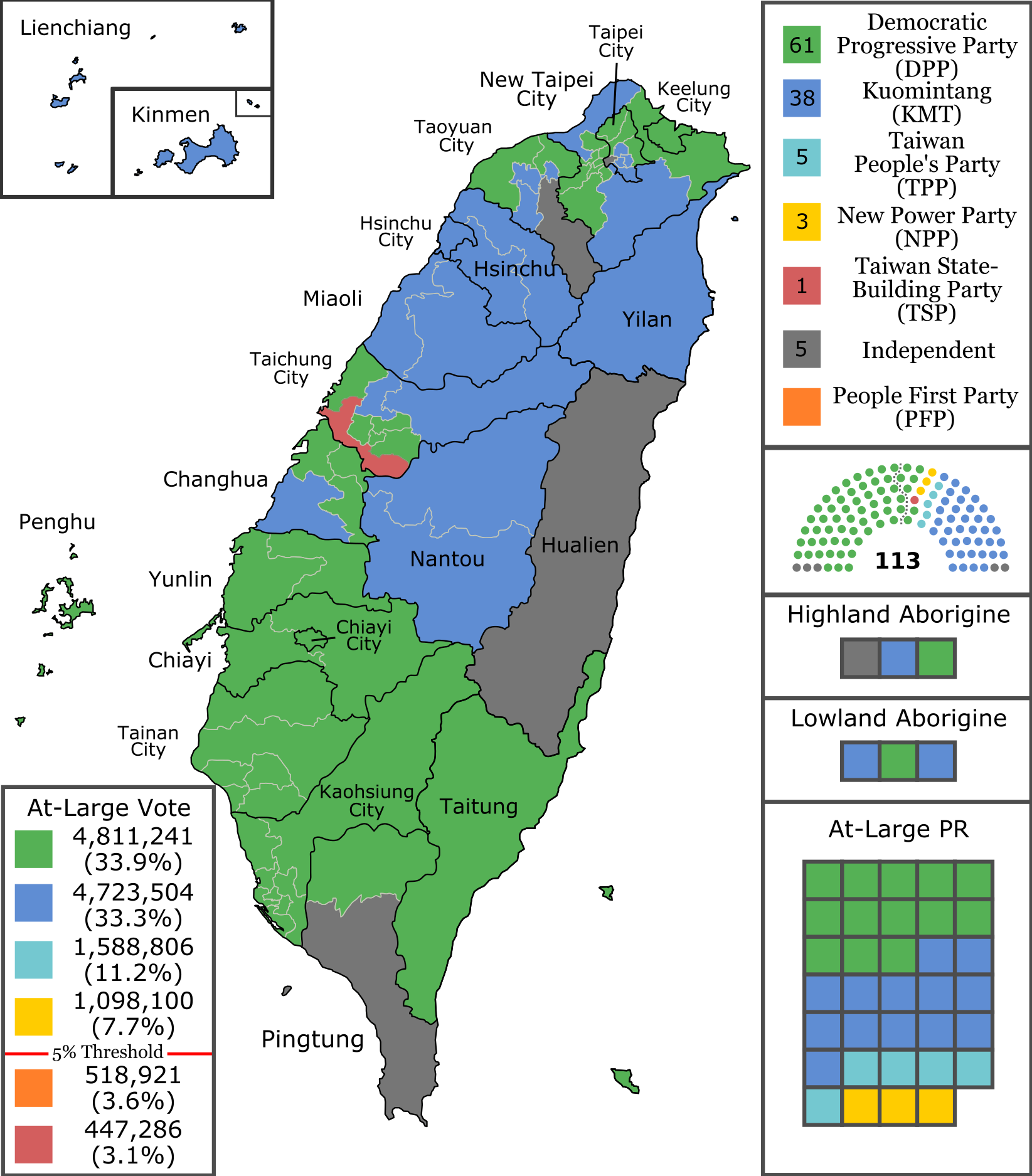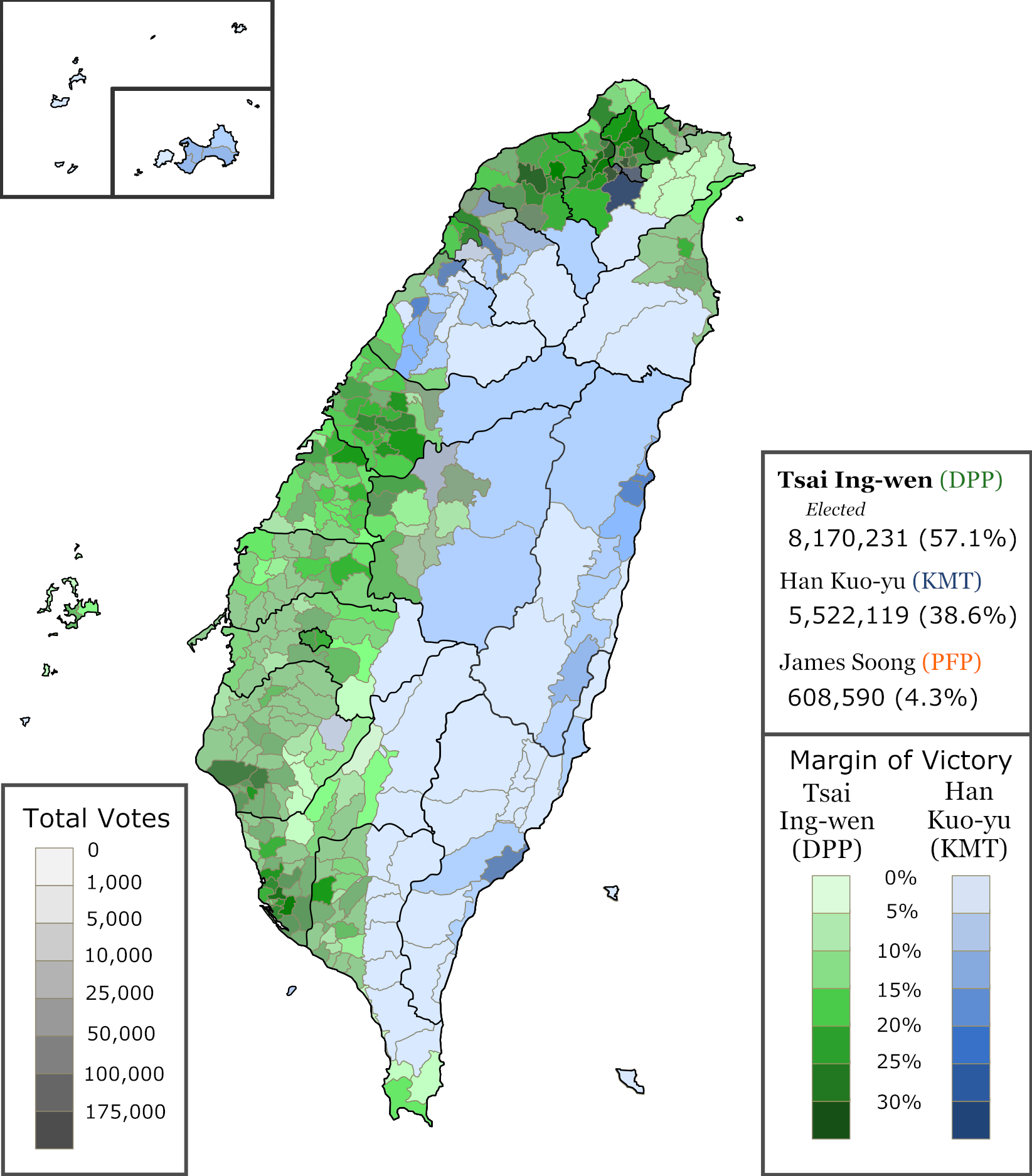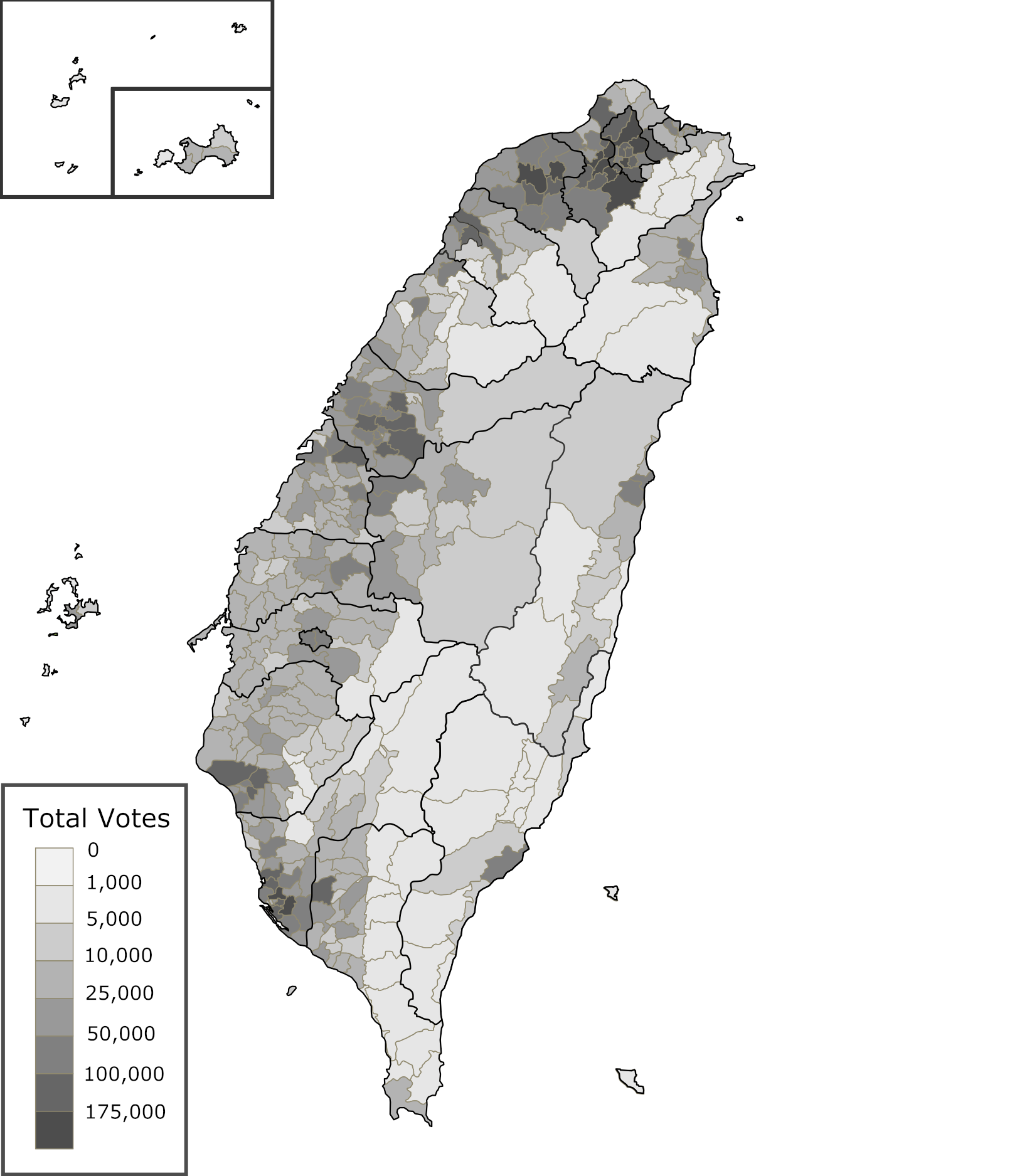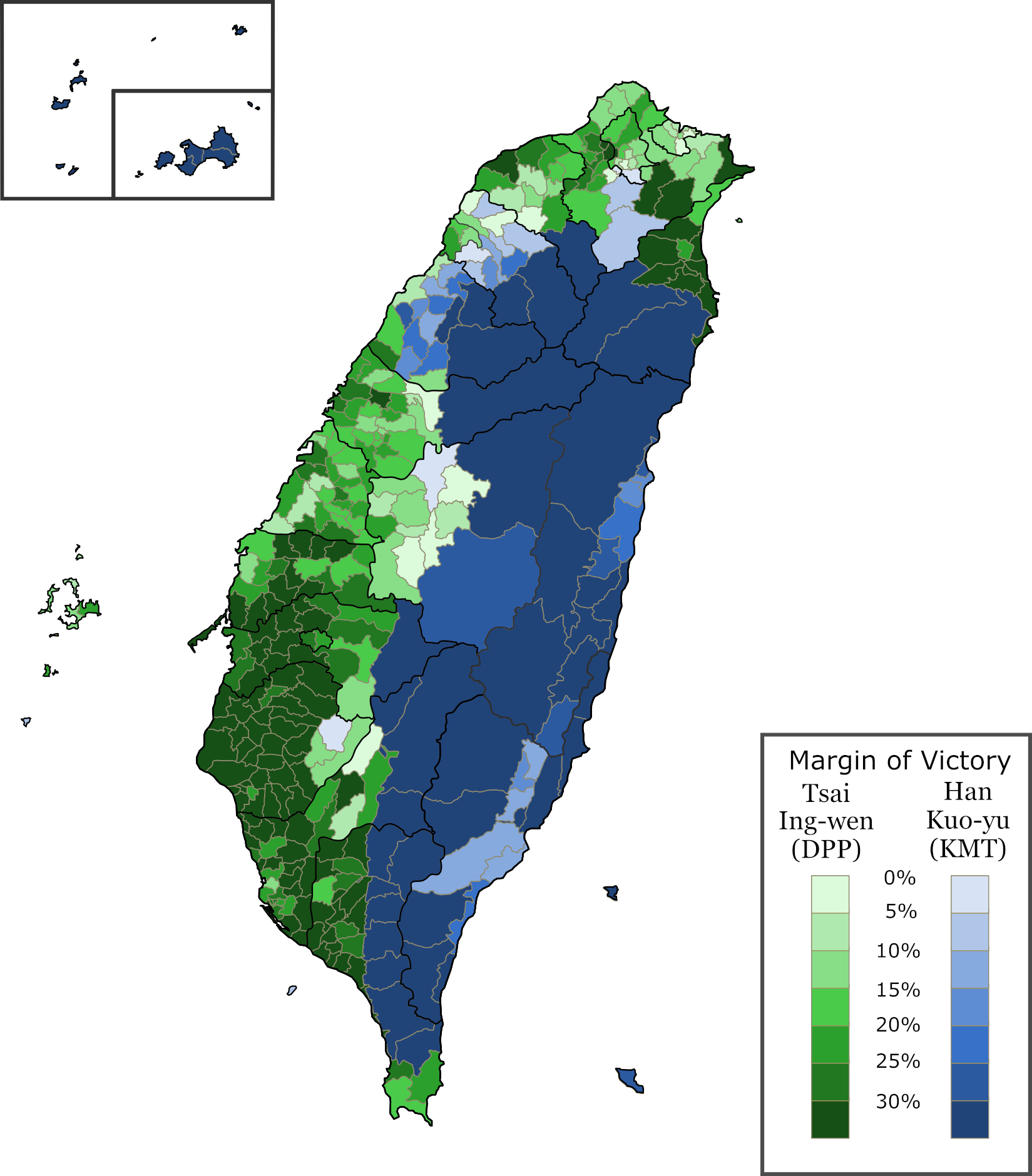Compass Elections: Taiwan – Reading the Results
Taiwan’s President Tsai Ing-wen, of the Democratic Progressive Party (DPP), won a second term in the election on January 11, staving off a challenge from the Kuomintang (KMT, or Chinese Nationalist Party) candidate, Mayor Han Kuo-yu of Kaohsiung. Tsai won reelection with a comfortable 57.1 percent of the vote, earning a record high 8.1 million votes. Han received 38.6 percent of the vote with 5.5 million votes. The turnout was 74.9 percent, up from the 66 percent turnout four years ago.
The DPP also retained its majority in Taiwan’s unicameral legislature, the Legislative Yuan, with 61 out of 113 seats, allowing Tsai to continue enacting her agenda. At the same time, this result, down from the DPP’s previous 68-seat majority, reflected falling support for Tsai’s party in Taiwan, even as the people handed her a second term.
The Kuomintang won 38 seats, up from its previous 35 seats. Taipei mayor Ko Wen-je’s centrist Taiwan People’s Party (TPP), newly formed in 2019, entered the legislature as the third-largest party with five seats. The New Power Party (NPP), formed by activists in the aftermath of the 2014 Sunflower Movement, remained in the legislature with three seats.
(Also here’s a great interactive tracker for the specific results made by the News Lens, for anyone interested.)
Should I Stay or Should I Go: A Refresher
The (formal) independence-versus-unification debate over Taiwan’s sovereignty and its relationship with the People’s Republic of China (PRC) remains the salient issue in Taiwanese politics, dwarfing all other issues. The two major parties and the various smaller parties are often first defined by where they stand on the independence-unification spectrum, and their other specific policies second.
Taiwan was ceded to Japan by the Qing Dynasty in 1895 and returned to the Republic of China (ROC) following World War II. Following the Communist victory in the Chinese Civil War, the Nationalist KMT government under Chiang Kai-shek fled to Taiwan, retaining only several small islands (Kinmen and Matsu) off the mainland coast. Taiwan remained a one-party state under the KMT throughout much of the later part of the 20th century until the lifting of martial law in 1987 under Chiang Ching-Kuo (son of Chiang Kai-Shek) and democratization under his handpicked Taiwan-born successor Lee Teng-hui. The first direct elections occurred under Lee for the Legislative Yuan in 1992 and the President in 1996.
The DPP won the presidency for the first time in 2000 with the election of Chen Shui-bian, during whose administration relationship with mainland China became notably strained. The KMT returned to power in 2008 with the election of Ma Ying-jeou amid economic slowdown and corruption scandals surrounding Chen and the DPP. Under Ma, Taiwan moved to improve relations with China, culminating in a landmark meeting between Ma and Chinese President Xi Jinping in Singapore in 2015.
At the same time, a free trade pact with China, negotiated behind closed doors, prompted backlash by Taiwanese youth, with hundreds of student protestors storming and occupying the legislature for weeks in 2014. In the aftermath of the student protests (nicknamed the “Sunflower Movement”), growing skepticism towards the KMT’s push for increased economic ties with China contributed to Tsai’s victory in the 2016 election.
The KMT, with its historical and cultural ties to the mainland, is sometimes said to be the pro-unification party; in contrast, the DPP has been called the pro-independence party. Yet this is a gross simplification of a much more complex situation.
The two main loose grouping of parties in Taiwan –– the KMT-centered “Blue” camp and the DPP-centered “Green” camp –– can better be understood as a coalition that favors a Chinese nationalist identity and rapprochement with the PRC, versus a coalition that favors a Taiwanese local identity.
Taiwan, still officially the Republic of China, has a complicated history with its political identity.
Most of Taiwan’s current inhabitants emigrated from coastal China in the centuries prior to Japanese colonial rule, displacing the small indigenous minority. Following the fall of the Nationalist government on the mainland, a few million mainland Chinese, mostly military and civil servants, also came to Taiwan. The mainland émigrés make up about 10 percent of the island’s population today.
Under Chiang Kai-Shek and his son, the Taipei government largely considered itself “Free China,” seeking to one day retake the mainland. This unrealistic policy was largely abandoned in favor of a “Taiwanization” policy under their successor Lee Teng-hui, emphasizing local culture and identity.
Under Ma, who had pledged “no independence, no unification, and no use of force” during his presidency, the KMT embarked on maintaining the status quo while seeking closer ties with the mainland. As a result, the KMT is divided into a main faction that favors the status quo, a faction that favors eventual unification, and a faction that favors localization, seeing it necessary for the eventual survival of the party.
Although former DPP President Chen Shui-bian had supported a campaign for de jure independence, his actions were widely seen as needlessly provocative against China. Under Tsai, the DPP has stuck to a more moderate stance, with Tsai repeatedly stating that she seeks to maintain the status quo with China. After Tsai’s campaign spokeswoman Lin Ching-yi made the controversial comments suggesting that proposing unification constituted “treason” a week before the election, the DPP distanced itself from Lin, who resigned soon after.
In contrast, smaller parties can afford to adopt more radical positions on the independence-unification spectrum. The conservative People First Party (PFP), led by the perennial presidential candidate James Soong, is usually seen as more outrightly pro-unification, espousing a gradual cross-strait rapprochement ending in “political integration.” The liberal Taiwan Statebuilding Party (TSP) and the NPP, in contrast, advocate outspokenly for formal independence and the creation of a Taiwan state.
The Legislative Election
Legislative election results. (Map by Kyle Wang)
Taiwan’s legislature is elected using three different systems. 73 of the 113 seats –– nearly two-thirds of the legislature –– are elected by simple majority (“first past the post”) in single-member constituencies across Taiwan’s 22 special municipalities, counties, and cities.
In addition, 34 “at-large” seats –– one-third of the total seats –– are elected based on proportional representation (PR) from a list of candidates internally determined by the respective parties. At the polls, besides the representatives for their district, Taiwanese voters also vote for the party they wish to support. Parties that receive more than 5 percent of the vote qualify for the PR seats in parliament (allocated with the Hare quota, for those who want to know).
Furthermore, six seats are reserved for Taiwan’s aboriginal communities, numbering about 2 percent (540 thousand) of the island’s 23 million population. People with aboriginal status can vote for one preferred candidate in their respective categories (“Lowland” and “Highland,” a somewhat arbitrary classification based on family household registration prior to 1945), with three seats each. The top three candidates with the most votes are elected in each categories.
Islands of Support
The district results don’t hold many surprises. The DPP held on to most of its seats in its traditional stronghold in southwest Taiwan, including Kaohsiung, after losing the city’s mayorship in 2018 to Tsai’s opponent, Han Kuo-yu. The DPP swept the seven southern counties and cities, as well as the Penghu islands, denying any seats to the KMT.
The KMT held on to its island strongholds, Kinmen and Matsu (officially Lienchiang County), where some residents identify as more Chinese than Taiwanese due to the islands’ proximity to China. Hsinchu and Miaoli historically vote KMT, being where Taiwan's Hakka communities is concentrated (there being a traditional antagonism between the Hakka minority and the Hokkien majority within the Taiwanese community, the latter being the DPP’s support base). The conservative mountainous central region and the sparsely-populated east coast also tend to vote KMT.
Competition is fierce in the northernmost special municipalities (Taipei, New Taipei, and Taoyuan), where more than a third of the island’s population lives. In a notable race, Chiang Wan-an, Chiang Kai-shek’s great-grandson, fended off a challenge from rising DPP star Enoch Wu for Taipei’s third district.
A notable KMT loss, however, was Taichung’s second district, where KMT legislator Yen Kuan-heng from the local political dynasty lost to the TSP challenger Chen Po-wei.
Most of the elected independents can be expected to vote with the DPP. Freddy Lim, NPP’s former leader, won Taipei’s fifth district as an independent, having departed the party after endorsing Tsai. Su Cheng-ching, who won Pingtung’s second district, is formally a DPP member. Chao Cheng-yu, reelected to Taoyuan’s sixth district, caucuses with the DPP. On the other hand, Fu Kun-chi, elected in Hualien, has appeared in KMT election rallies with Han.
Taiwan’s indigenous people, traditionally a reliable KMT base, reelected three KMT members and one KMT-aligned independent to parliament. Yet the DPP appears to be making inroads with indigenous voters, increasing its share of the aboriginal seats from one to two. Tsai – who is herself part indigenous – previously became the first Taiwanese president to officially apologize to the indigenous population for centuries of mistreatment in 2016.
I've Got a Little List
In the run-up to the election, controversy erupted over the usually obscure party lists. Both the DPP and KMT can usually expect at least one-third of the total vote each, effectively guaranteeing their first ten listed candidates seats in the legislature, regardless of the individual politicians’ popularity or political stances.
Following the release of the party lists in November 2019, a furor arose over the KMT’s decision to place several overtly pro-unification, pro-Beijing politicians in the forefront positions. For example, retired Lieutenant General Wu Sz-huai, number four on the KMT’s list, previously led a delegation of retired officers to Beijing in 2016, where he listened to an address by Chinese President Xi Jinping and stood for the Chinese national anthem. Although a previous list containing more controversial candidates was withdrawn and revised by the KMT, Wu remained on the list (and has since been elected).
The KMT, once seen as likely to retake the legislature following its victory in the 2018 municipal elections –– it still led in polls prior to the list’s release –– may have suffered a crucial hit in support as a result of their party list, ultimately winning around only a third of the seats in parliament.
Nevertheless, despite Tsai’s resounding victory over Han in the presidential election, the KMT is practically neck and neck with the DPP for the at-large vote: the DPP’s 33.9 percent against the KMT’s 33.3 percent, each taking 13 at-large seats. DPP support fell from 44.1 percent in 2016, while KMT support grew from 26.9 percent since.
The party that benefited most from the loss in DPP support is probably Taipei Mayor Ko Wen-je’s newly-formed TPP, which secured 11.2 percent of party votes and became the third-largest party in parliament, with five seats. Ko’s TPP claims to represent a middle-of-the-road approach with China (its party color, turquoise, even mixes KMT blue and DPP green).
The NPP, whose main support came from younger voters, likewise gained from the loss of DPP votes, with its share of the at-large vote up from the 6.1 percent it had four years ago.
Disillusionment
Tsai’s domestic policies likely lost her party support. While there is indeed a conservative backlash, even within her own party, against the 2019 legalization of same-sex marriage (a first in Asia), the souring domestic pereception of the DPP since Tsai’s first election stemmed more from the party’s subsequent record on labor and welfare issues.
After coming into office, Tsai continued the pro-business policies of her KMT predecessor in the hope of stimulating the economy. In late 2016, the Tsai administration amended the Labor Standards Act, removing seven public holidays and allowing workers one guaranteed day off and one “flexible rest day” (subject to overtime pay) per week. In early 2018, a new set of amendments to the law were passed, intended to add flexibility for workers in response to industries with irregular scheduling requirements (e.g., agriculture and tourism industries). The amendments shortened the mandatory rest time for shift workers from eleven to eight hours, while allowing businesses to ask employees to work twelve days in a row. The amendments sparked protests by labor groups and the NPP, whose legislators started a hunger strike. This controversy alienated the labor sector and the left, damaging the DPP’s progressive image.
Pension reform, on the other hand, went more smoothly but mobilized the KMT base. Warning that the previous system, a remnant of the Chiang Kai-shek era, is “on the brink of bankruptcy,” the Tsai administration in 2018 cut annual pensions for military veterans, civil servants, and teachers from 18 percent to 6 percent. Veteran groups (led by figures like Wu Sz-huai) staged large-scale protests, forcing police to barricade the legislature with barbed wire, while brawls broke out on the debate floor between KMT and DPP legislators. Energized KMT supporters turned out in droves for the municipal elections later that year, dealing a hard blow to the DPP. Han, in his presidential campaign, had also vowed to restore the pension if elected.
Furthermore, younger voters may have felt disillusioned with the DPP. Tsai had entered office on a promise of reform, but was perceived as backtracking from doing so during her first term, with some even criticizing her party for looking like “another KMT.” More hardline supporters of independence likewise may have felt snubbed by Tsai, who backed the status quo. Tsai’s own premier, William Lai, seen as more explicitly pro-independence, launched a primary challenge against Tsai (later joining her on the ticket as the vice presidential nominee as a show of unity). This is also reflected in the election results, where a large percentage of Tsai voters voted for her but not with the DPP, instead preferring the smaller third parties, particularly those with a greater youth presence and explicitly supporting independence.
The Panda In The Room
Presidential election result by townships and districts, adjusted for population. (Map by Kyle Wang)
Below: The total votes map and the unadjusted margin of victory map.
Once poised to lose reelection following the 2018 municipal elections, Tsai staged a comeback in 2019, culminating with her landslide victory on January 11. This reversal in fortunes relied on a number of factors, most significantly a rising wariness of the threat from across the Taiwan Strait.
President Xi Jinping, warning that unification is inevitable, urged Taiwan to accept his offer of “one country, two systems” in his 2019 New Year speech. Hours after, Tsai forcefully rejected the suggestion, voicing her support for Taiwan’s sovereignty and positioning herself as the defender of the island’s democracy, a mantle she has embraced ever since. Her approval ratings to increased as well, starting the return from her nadir.
The Hong Kong protests beginning in June 2019 certainly helped her by putting the KMT on the defensive (though the specific effect is debatable). Tsai repeatedly invoked the slogan “Hong Kong today, Taiwan tomorrow” to mobilize the party’s youth voters, casting the election as a life-or-death choice for the island’s future. The rising turnout this election, where most new voters are likely are young, seemed to validate such a voter mobilization strategy.
Han unsuccessfully tried to cast himself as a defender of Taiwan’s democracy as well, at one point declaring “over my dead body” in response to the possibility of “one country, two system” being implemented in Taiwan. Yet his previous friendliness with China, including a visit to the Beijing-run Hong Kong Liaison Office in March 2019, may not have convinced many voters on this.
At the same time, Tsai also leaned into her internet-bestowed image as the “Iron Cat Lady” throughout the campaign, rebranding herself as a strong and caring politician who also seems cool in an attempt to win the hearts of young voters. Han’s evocation of Taiwan’s glory days, while whipping up support from an older generation of voters, appeared disconnected with the whims of younger voters.
Many people in Kaohsiung, where Han is the mayor, also felt dissatisfied with Han, accusing him of spending more time on the campaign trail than on city affairs. A recall campaign against Han is currently in process, and Han even lost the city’s presidential election vote.
Nevertheless, although Han lost, he still won more votes than Eric Chu, the previous KMT candidate in 2016, who won only 3.8 million votes (31 percent). Most of the KMT voters who abandoned the party in 2016 for the PFP’s James Soong likely returned to the fold, leaving Soong with only 608 thousand votes (4.3 percent), compared to the 1.5 million (12.8 percent) he received last time.
What's Next?
The results of the election as a whole showed that, while Taiwan’s voters overwhelmingly chose to give Tsai four more years, they do not necessarily support the DPP to the same degree. Conversely, while voters rejected Han as a candidate, it does not mean they repudiated the KMT as a party. The KMT’s party list also ensured that more pro-China legislators will enter the legislature on February 1, when the new session starts.
The KMT will likely do some soul-searching about the party’s future. The 5.5 million voters mobilized by Han’s campaign shows that such a populist style could work, and Han voters would not simply go away. On the other hand, some analysts see youth outreach as the key for the party’s future, and some younger KMT members are suggesting that more Taiwan-centered proposals are needed.
Tsai has reiterated that she will preserve the current status quo upon reelection, continuing the use of the nomenclature “Republic of China (Taiwan)” in her victory speech. Despite this, China has previously perceived Tsai’s emphasis on the island’s sovereignty as a promotion of formal independence. In response, Tsai accused China of shifting the goalposts of what the “status quo” entails.
How Beijing will respond to four more years of DPP rule will be worth watching. Unless China changes its policy towards Taiwan (unlikely), relations will likely remain chilly across the Taiwan Strait. Two weeks before the election, the DPP-controlled legislature had pushed through the controversial Anti-Infiltration Act, prohibiting China-funded political donations and lobbying, in response to allegations of Chinese election interference. While Tsai has stated that regular cross-strait interactions will not be targeted, the law still caused concern among the business community, which fears deteriorating cross-strait relations.
Although China’s maneuvers to poach away the island’s remaining formal diplomatic allies will therefore likely continue, it is unlikely to put much pressure on the Tsai administration’s domestic support. Taiwan still maintains unofficial diplomatic relations with many major countries, including the U.S., Japan, and most of Europe. The island’s manufacturing industry also benefited through diverted capital from the China-U.S. trade war. Despite China’s efforts to put economic pressure on the island by suspending individual tourist permits in July, the annual tourist numbers has also reached an all-time high of 11.8 million.
The Tsai administration may pursue further reforms now that the DPP has secured a perceived mandate. After the unpopular reforms of her first term, Tsai will likely pursue less controversial ones to maintain her restored image as a reform candidate. Wage inequality has become a major domestic issue with middle-class salaries stagnating over the past decade. In Tsai’s first term, her administration raised the minimum wage four times. Nevertheless, the growth in wages still lags behind comparable economies, making minimum wage increases unlikely to alleviate the predicament faced by lower-income workers. Addressing this issue, which Han seized on, would be important if the DPP wishes to avoid future challenges from populists.
The Tsai administration would also need to embrace progressive policies to maintain the support of its youth base, after being perceived as backtracking from doing so in her first term. Improved social services including subsidized childcare, which appeals to younger couples, became one of Tsai’s key campaign pledges. Other promises include health care and education reform.
The Tsai administration will likely continue its pledge of delivering transitional justice as well. Following the February 28 massacre of Taiwanese protesters by KMT authorities in 1947, political dissidents in Taiwan have been harshly suppressed in a period known as the “White Terror” until the end of martial law in 1987. The administration established the Transitional Justice Commission in 2018, tasked to uncover past atrocities and “heal social wounds.”
(And one last thing –– the murder suspect whose case sparked the Hong Kong protests is likely to finally turn himself in to Taiwanese authorities after being freed in October. Tsai was accused of politicizing the case to aid her reelection.)
Tsai will officially start her second term in office on May 20. With Chinese affairs becoming more and more relevant to other global powers, Taiwan’s actions at home and abroad may take on new significance. The “Iron Cat Lady” has a lot on her plate.




